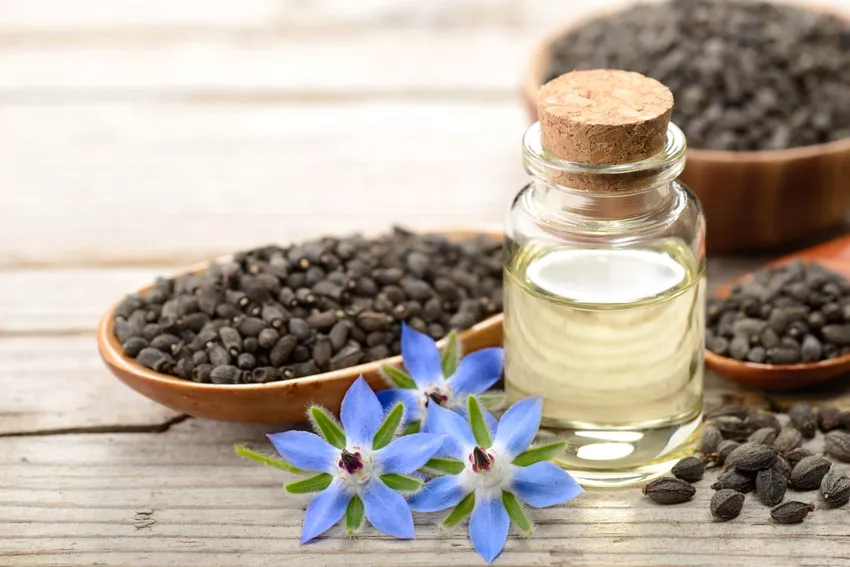Borage has been repeatedly discredited for being poisonous. And not without reason - it contains phytochemicals that are also potentially harmful to humans.

Borage (Borago) is a popular culinary herb. It is used in the Frankfurt green sauce, in herb quark or in salads. But is it actually safe to eat borage? Or is the herb actually poisonous? In this article we explain whether borage is poisonous to humans or animals and how it is used medicinally.
Can you eat borage?
Yes, you can eat borage. Borage has a very special taste: the herb with the hairy leaves tastes fresh and is reminiscent of cucumbers. The blue flowers are also often used as an edible decoration for salads or appetizers. Borage seed oil is used in salad dressings, pesto and dips. But just because you can eat it doesn't mean it's he althy, right?
What ingredients in borage might be unhe althy?
Borage contains alkaloids - and these should be looked at more closely. Strictly speaking, it is the 1,2-unsaturated pyrrolizidine alkaloids that the plant uses as so-called secondary plant substances to defend itself against predators. Pyrrolizidine alkaloids are also found in other borage plants, such as comfrey (Symphytum) and viper's bugloss (Echium).
The alkaloids are mainly contained in the leaves, flowers and stems of the aromatic herb. They are found in smaller amounts in the seeds, and accordingly in borage oil, which is extracted from the seeds. Borage oil is low in pyrrolizidine alkaloids, although it should also be used with caution. It contains about 1.5 to 3.5% of so-called erucic acid. It has been known for many years that it not only tastes bitter, but is also harmful to he alth in high concentrations.

Is borage poisonous to humans?
The Federal Institute for Risk Assessment (BfR) has been investigating for some timethe contamination of food by pyrrolizidine alkaloids, as these can damage the liver and show genotoxic and carcinogenic effects. Herbs such as borage (Borago), oregano (Origanum) and lovage (Levisticum) naturally become special found high levels of the alkaloids. In borage, for example, eight samples were found to have a mean of about 50 μg/kg, with a maximum of about 248 μg/kg. For non-carcinogenic effects, the BfR specifies a guide value of 0.1 μg/kg body weight and day - below this value no acute damage occurs. With an average of 50 µg of the pyrrolizidine alkaloids per kg of borage and an average body weight of 75 kg, the recommended guideline value would already be reached with the consumption of 150 g of borage.
In the EU, the ALARA principle (as low as reasonably achievable) applies to substances with genotoxic and carcinogenic effects and is therefore a recommendation to minimize exposure to these substances .
You should definitely avoid borage in high concentrations, such as in dried plant powder, smoothies or juice. Pregnant women, breastfeeding women and small children should be particularly careful, as even small amounts can be risky. Eating borage should always be done with caution. Regular consumption is also not recommended.

The high levels of erucic acid in borage oil can be harmful to he alth by making the heart fat if consumed too often. You should therefore refrain from consuming too often and prefer to use alternative oils.
Is borage poisonous to humans?
- Borage contains pyrrolizidine alkaloids which are suspected to be harmful
- Many pyrrolizidine alkaloids are hepatotoxic, carcinogenic and genotoxic
- Regular and excessive consumption should be avoided. An adult human should not consume more than 150 g of borage at a time
- Pregnant women, nursing mothers and young children should not eat borage
- Due to the erucic acid it contains, borage oil should only be consumed in moderation
Can you eat borage flowers?
Borage flowers are edible - the blue stars are particularly good as decoration. However, pyrrolizidine alkaloids are also present here. Occasional consumption of the edible flowers is acceptable.

Can you eat borage leaves?
Borage leaves are also edible. However, since borage contains more toxins than other herbs, borage should not be used primarily. For example, replacing spinach or regularly replacing cucumber in salads is strongly discouraged.
Is borage poisonous to pets?
If animals such as dogs, cats or guinea pigs nibble on borage, you don't have to worry too much about your four-legged friend. Although the animals absorb small amounts of alkaloids by nibbling, these do not harm the animals in small doses. In addition, the bitter substances in the leaves make borage taste inedible to animals.

Use of borage as a medicinal plant
The healing properties of borage related to the purification of blood and against melancholy from the Middle Ages to modern times. Cucumber was long considered a medicinal plant for fever, diarrhea, inflammation and other diseases. The flowers in particular were very popular as medicinal flowers until the Federal He alth Office in 1991 classified therapeutic use as unacceptable due to the alkaloids in borage.
Nowadays the medicinal properties of borage are mainly used in teas, infusions and in the form of oil. However, there is no scientifically proven effect of borage and due to the high proportion of alkaloids, its use is controversial. According to the current state of knowledge, borage oil is considered to be free of pyrrolizidine alkaloids. However, its erucic acid content is closely monitored and even stricter content limits are currently under discussion. Borage oil is used, for example, in the therapy of various heart and nervous diseases and against diabetes.

You want to enjoy the blue flowers in the garden or on the balcony? Read our article on how to grow borage and where it thrives.